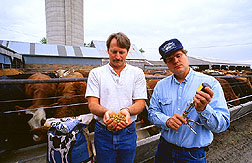First Genetically Engineered Vaccine for Shipping Fever
|
|
A cure for livestock respiratory disease has long eluded researchers. This ailment costs U.S. and Canadian cattle producers more than $1 billion annually. But now a new live vaccine developed by Agricultural Research Service researchers promises to substantially reduce these losses.
Shipping fever, as the disease is more commonly known, affects calves about 1 week after they are transported from the cow and calf operations where they were born to the feedlots where they finish their growth. It is the biggest killer of beef cattle in feedlots.
The culprits are three different bacteria that are usually harmless--Pasteurella haemolytica, P. multocida, and Haemophilus somnus. Normally present in cows' nasal cavities, these bacteria usually don't cause problems--until the young animals are readied for shipment. Then the stress of handling and shipping takes a toll on their immune systems, and the bacteria move into their lungs and cause pneumonia.
The disease can hit the pocketbooks of both shippers and receivers. Animals that look healthy when purchased may arrive at their destination with decreased appetite, fever, coughing, and nasal discharge. If they survive, infected beef cattle grow poorly and need more time and feed to reach market weight. The same bacteria also infect sheep and goats.
ARS veterinarian Robert E. Briggs and microbiologist Fred M. Tatum created a live vaccine by deleting a large piece of a gene called aroA from each of the three bacteria. Without this gene, the bacteria do not cause infection.
These are the first genetically engineered vaccine strains for shipping fever that have been made without using foreign DNA or a marker for antibiotic resistance, says Tatum.
Most shipping fever vaccines are made from bacterins--suspensions of killed bacteria--or from specific bacterial proteins. The immunity they confer has left much to be desired.
A live vaccine is more effective because it gives disease resistance much like convalescent immunity to the animal, says Briggs. Similar to what happens when someone recovers from mumps or measles, this type of immunity is typically stronger and longer lasting than that conferred by killed vaccines.
Several patents on the vaccine technology have been issued jointly to ARS and the Biotechnology Research and Development Corporation in Peoria, Illinois. BRDC is a public-private organization formed to speed commercialization of government-funded research discoveries. Member company Schering-Plough of Madison, New Jersey, has licensed the technology to make multivalent injectable vaccines and is in the process of getting approval to market the new product.
Meanwhile, Briggs and Tatum are working on an oral vaccine that can be given to animals via their feed. Recently, 100 head of cattle were shipped from Tennessee to Texas. Some of the calves received the oral vaccine 4 days before shipping and others didn't. All of the calves fed the oral vaccine were protected, while 10 nonvaccinated calves died from pneumonia.
If proved effective, producers might find that feeding the vaccine is easier and less time-consuming than intramuscular injections.--By Linda Cooke McGraw, Agricultural Research Service Information Staff.
Robert E. Briggs and Fred M. Tatum are in the USDA-ARS Respiratory and Neurologic Disease Research Unit, National Animal Disease Center, P.O. Box 70, Ames, IA 50010; phone (515) 239-8639, fax (515) 239-8458.
"First Genetically Engineered Vaccine for Shipping Fever" was published in the December 1998 issue of Agricultural Research magazine.







